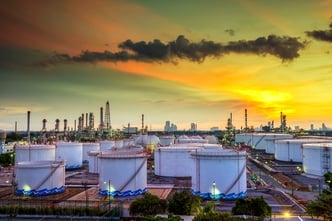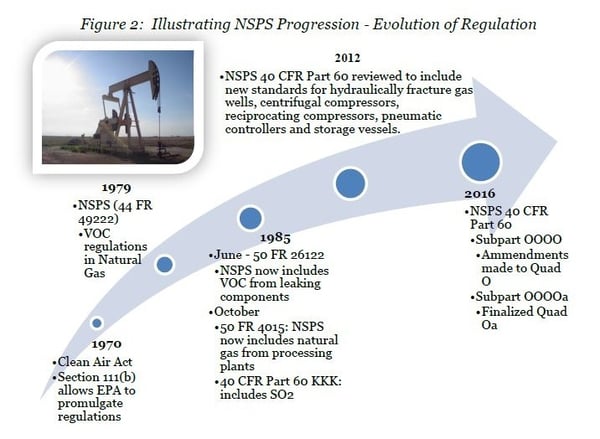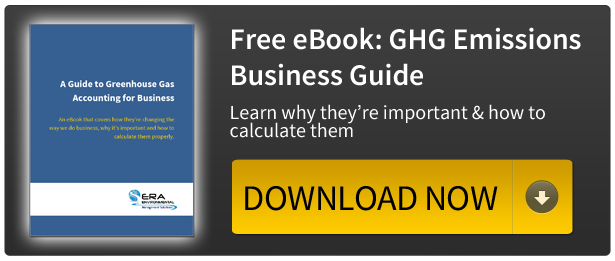
This is the second of two blog posts that will take a close look at new changes to Sub Part W reporting, which are set to swing into place over 2017.
As we have previously explored, 2017 will see this important realignment amongst Oil & Gas operators. This shift primarily will concern production, transfer and storage locations that are engaged in New Source Performance Standard OOOO (Quad O) and/or OOOOa (Quad Oa) reporting, as per US regulations.
The change revolves around how the Greenhouse Gas (GHG) reporting program’s Sub Part W requirements are set to aligned with the existing NSPS Quad O and Quad Oa reporting processes.
This year, data inputs utilized in Sub Part W reporting will reflect those from the existing NSPS Quad O/Oa reporting processes.
This represents a considerable streamlining of data processing for all facilities engaged with this reporting.
The purpose of this article is to examine exactly which segments of the oil & gas industry will be affected, as well as highlighting some of the best ways in which your facility can demonstrate compliance.
Industries Concerned

Part of the reasoning behind the emergence of this new reporting process is that it will further promote robust reporting in a dynamic and changing domestic energy market.
With the boom in hydraulic fracturing over recent years, the number of firms engaged with that method of oil and gas production has skyrocketed. In addition to the growth in hydraulic fracturing, the comparatively lower production cost of producing liquefied natural gas means that many more established firms involved with this product are ramping up production across the United States. An improved export scenario further underpins this healthier production environment.
This makes for a lot of activity within the US oil & gas market. However, delivering the kind of detail-focussed reporting that the EPA now expects means that oil & gas producers of all types will need to ensure their reporting in good shape. This industry segment will actually benefit from the streamlining of data behind the reporting processes outlined above. The streamlining means that firms of any size will have one less data gathering process to carry out.
That said, an attention-to-detail focussed EH&S culture is nonetheless essential in actually capturing the information required by the EPA and state regulators.
True to their name, the fugitive emissions that are the subject of this level of reporting can be exceedingly difficult to accurately capture. The use of scientifically rigorous continuous monitoring systems (CMS) may be called for if truly accurate measurements are to be obtained.
Additionally, the intricacies of tank management solutions cannot be understated. The various aspects of managing tank transfers, mixing, and external environmental factors all need to be accounted for.
With these challenges in mind, compliance evaluation will be the major challenge for any oil and gas company filing reports in March 2017.
Only by engaging a detailed-focussed environmental measuring and reporting solution can these kinds of measurements needed be ascertained. The onus falls on oil & gas companies to engage with this kind of meticulous measurement.
Demonstrating Compliance

March of 2017 will see the first deadline for Sub Part W reporting under this newly streamlined set-up. March 31 is the date when these reports will need to be submitted by.
As previously mentioned, clients in the oil and gas sector will want to pay particular attention to these requisites, as many will fall under the conditions for reporting.
Those facilities involved with the following processes will be more subject to this change:
- Production
- Gathering and Boosting
- Distribution and Transmissions Pipelines
- Liquefied Natural Gas (LNG) Import and Export Equipment
- LNG storage
- Underground Natural Gas Storage
- Transmissions Compression
This will particularly be the case with those facilities involved with production, gathering and boosting, distribution and transmissions pipelines, liquid natural gas import and export equipment, underground gas storage or transmissions compression.
According to the published definitions, any facility that emits more than the established threshold of 25,000 metric tons of CO2 per year will fall into the ‘required to report’ bracket.

It should be stressed that report submissions should be compiled well in advance of the March 31 deadline, ideally with time to spare for both compilation and assessment.
The usual inclusive process for GHG reporting should be respected, with all possible records of equipment leaks and vented Co2 and methane being included. In addition to this, flares and any combustion processes that burn both CO2, methane and nitrous oxide (NOx) should be included in the compilation.
All measurements and reports should be fully dated, with the results of all emissions tests, along with calibration reports for detection and measurement instruments, input and output calculations, plus information on any emission computer model runs whenever a “missing data” procedure was undertaken.
Proper consideration should also be given to sources when assessing both federal and state requirements in producing these reports – which may differ depending on locality.
Ideally, businesses should make use of a comprehensive solution that can take all these factors into account, and produce a comprehensive e-report for instant delivery to the regulator.
For the final submission process, separate reports (Sub Part W and NSPS) will still need to be generated and submitted. The Sub Part W report consists of a fully detailed spreadsheet that can be submitted online, via the e-GGRT system.
Electronic submission of NSPS reports is also strongly encouraged, with digital state-specific submission made possible in 2015.
Conclusion

The current reporting programs, be they GHG or NSPS-related, operate as a strong baseline for environmental reporting.
As indicated above, however, EH&S accuracy can only be reliably and regularly attained through instituting a robust reporting culture at your facility.
As we have previously recapped, this reporting realignment should further encourage facilities to implement two positive “bottom line” steps.
- Ensure a better environmental record by identifying and properly reporting fugitive emissions, thus reducing both fine amounts.
- Achieve better savings on a per-facility basis by indentifying fugitive emissions and taking steps to prevent these emissions – resulting in less product loss over time.
To help achieve these benefits, ERA offers an environmental reporting solution that tracks and verifies that all regulatory requirements (state and federal) are maintained, ensuring robust compliance management is being adhered to across your facilities.
With the ability to determine emissions from any source using product within an emission factor, true insight can be delivered through the application of this software, granting sustainability insights beyond the legally required reporting.
Tanks management software will also be of exceptional use, especially to oil & gas producers, with all aspects of chemical and fuel mixture management being more easily managed.
For additional information on how ERA can help you achieve reporting accuracy and help you deliver a better sustainability performance, please feel free to consult the free PDF guide below. ERA are happy to answer any questions you may have on Sub Part W, including any impact it may have on your business.
For any further questions, please feel free to email us via info@era-ehs.com.
This Blog Was Co-Authored By:


Tags:
Air Management
February 1, 2017

Comments